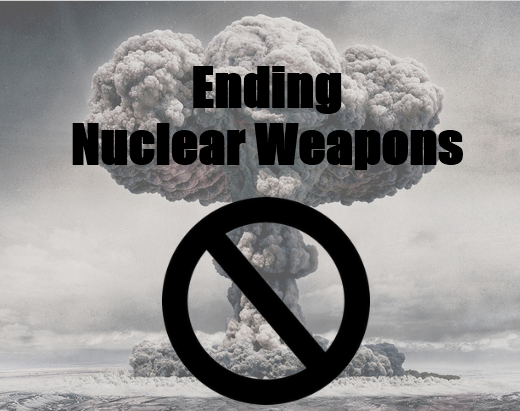Nuclear Weapons are
a Humanitarian Threat
A Humanitarian Atrocity
A nuclear bomb will kill or injure
thousands of innocent people
Remembering Hiroshima & Nagasaki
On August 6, 1945 an estimated 80,000 people were
immediately killed in Hiroshima, and on August 9 around 40,000
people were instantly killed in Nagasaki. Then afterwards, it is
estimated that over 80,000 more people died of radiation poisoning
and injuries. Many also suffered blindness, deafness, and ruptured
organs. Many initial survivors from the blast soon died from a
lack of medical services, because most hospitals were destroyed
and about 9 out of 10 doctors were killed or injured.
In March 2013, at a
Conference
in Oslo, Norway, 128 governments, UN agencies, international
organizations, scientists and civil-society representatives,
addressed the catastrophic humanitarian consequences of any use of
nuclear weapons, and all agreed that this is unacceptable.
Immediate Destruction of life
Just one nuclear bomb hitting a large city could kill millions of innocent people, and millions and millions would die if nuclear weapons were launched on several cities. Then, in the months afterwards, many more people could die of hunger and sickness, because healthcare responders would be unable to safely enter the contaminated area.
The explosion of a nuclear weapon releases intense heat, fierce blast waves, and radiation (radioactive particles) – killing or injuring massive numbers of people, obliterating homes and buildings, destroying all of the vegetation and local ecology, and poisoning the land, water and air for a very long time.
The blast immediately kills many thousands of people, while also causing severe burns, lung injuries and internal bleeding to people further away. The extreme heat also causes a giant firestorm over the surrounding area. Even people in underground shelters face probable death, due to a lack of oxygen and carbon monoxide poisoning. Also, physicians and health workers would be unable to help people in these highly dangerous radioactive areas.
Then, in the years to come, many more innocent people will die from nuclear radiation. Just one nuclear explosion will cause tragic long-term health problems and genetic disorders for thousands of adults and children, and through many generations. In addition, there are long-term environmental problems from nuclear-radiated soils and water, lasting for generations. This results in long-term unproductive soils and long-term health issues due to poisoned water.
There is nothing more harmful and destructive of life. And right now, the US, Russia, and China have enough nuclear weapons ready-to-deploy to obliterate all life of Earth.
Long-term harm from radiation
Nuclear explosions produce harmful radiation, which sickens people, causes cancer and genetic damage, and kills people after a few years, while also poisoning the land for decades. So even the survivors of a nuclear bomb will develop severe health problems and face an early death. Even nuclear testing causes serious health problems, and many scientists think that over 2 million people worldwide will have died from the effects of nuclear tests.
Nuclear radiation also causes harmful genetic disorders in children born from parents exposed to this radiation, and just one nuclear explosion could expose thousands of innocent people to this harmful radiation. These genetic disorders result in child deformities and lifetime health problems. Any parent would be very concerned and troubled about this. In addition, the public health costs would be huge in dealing with these health problems of future generations.
Environmentally, the use of just one percent of all nuclear weapons in the world would so severely disrupt the global climate that 2 billion people could die of starvation from a nuclear famine, and the destruction of essential ecosystems could end most of life on Earth.

for eliminating
Nuclear Weapons
exit
back
exit
back